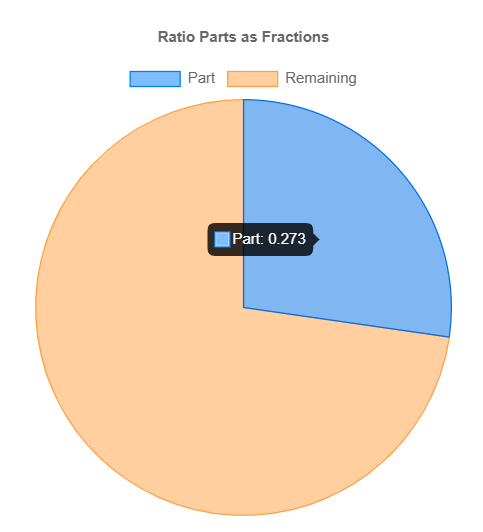Ratio to Fraction Calculator

1. What is the Ratio to Fraction Calculator?
Definition: This calculator converts a ratio of the form A:B into a simplified fraction A/B, supporting both part-to-part and part-to-whole ratios. It uses data inspired by standard mathematical practices to simplify fractions using the Greatest Common Divisor (GCD).
Purpose: It simplifies the process of converting ratios to fractions, which is useful in mathematics, statistics, and real-world applications like cooking, finance, and data analysis. The calculator helps users understand the proportional relationship between two quantities as a fraction.
2. How Does the Calculator Work?
The calculator converts a ratio \( A:B \) to a fraction by setting \( A \) as the numerator and \( B \) as the denominator:
(Text fallback: Fraction = A / B)
It then simplifies the fraction by dividing both \( A \) and \( B \) by their Greatest Common Divisor (GCD), computed using Euclid’s Algorithm:
(Text fallback: GCD(a, b) = GCD(b, a mod b) until b = 0)
For part-to-part ratios, it also computes part-to-whole fractions:
(Text fallback: Part 1 Fraction = A / (A+B), Part 2 Fraction = B / (A+B))
Steps:
- Enter the ratio A:B as two positive integers.
- Select the ratio type: Part-to-Part or Part-to-Whole.
- The calculator converts the ratio to a simplified fraction A/B.
- For part-to-part ratios, it also computes the part-to-whole fractions for both parts.
- Results are displayed in a table and visualized as a pie chart showing the fractional parts.
3. Importance of Converting Ratios to Fractions
Converting ratios to fractions is essential for:
- Mathematics: Simplifies calculations involving proportions and percentages.
- Data Analysis: Helps interpret relationships between quantities in statistics.
- Practical Applications: Useful in recipes (e.g., mixing ingredients), finance (e.g., debt-to-equity ratios), and design (e.g., aspect ratios).
- Educational Understanding: Enhances comprehension of proportional relationships.
4. Using the Calculator
Example 1: Convert the part-to-part ratio 7:11 (e.g., boys to girls) to a fraction:
- Input: Ratio 7:11, Type: Part-to-Part
- Simplified Fraction: 7/11 (already simplified)
- Part-to-Whole: Boys = 7/18, Girls = 11/18
Example 2: Convert the part-to-whole ratio 6:14 (e.g., apples to total fruit) to a fraction:
- Input: Ratio 6:14, Type: Part-to-Whole
- Simplified Fraction: 6/14 = 3/7
- Part-to-Whole: Apples = 3/7, Remaining = 4/7
5. Ratio vs. Fraction
The calculator handles both ratios and fractions, which are mathematically equivalent but used differently:
- Ratio: Typically compares two quantities (e.g., 7:11 for boys to girls) or a part to a whole (e.g., 6:14 for apples to total fruit).
- Fraction: Represents a part of a whole as A/B, often used to express proportions directly (e.g., 7/11 or 3/7).
6. Frequently Asked Questions (FAQ)
Q: What is the difference between part-to-part and part-to-whole ratios?
A: A part-to-part ratio compares two distinct groups (e.g., 7:11 boys to girls), while a part-to-whole ratio compares a subset to the entire set (e.g., 6:14 apples to total fruit).
Q: Why simplify the fraction?
A: Simplifying the fraction (e.g., 6/14 to 3/7) makes it easier to understand and use in calculations.
Q: Can the calculator handle non-integer inputs?
A: No, this calculator requires positive integer inputs for A and B to ensure accurate fraction conversion.
Q: How does the pie chart help?
A: The pie chart visually represents the fractional parts as proportions of a whole, making the ratio’s composition easier to understand.